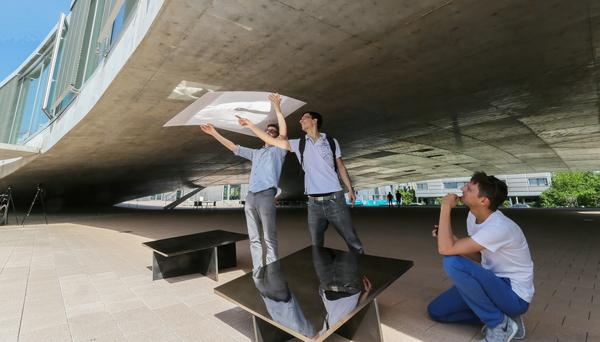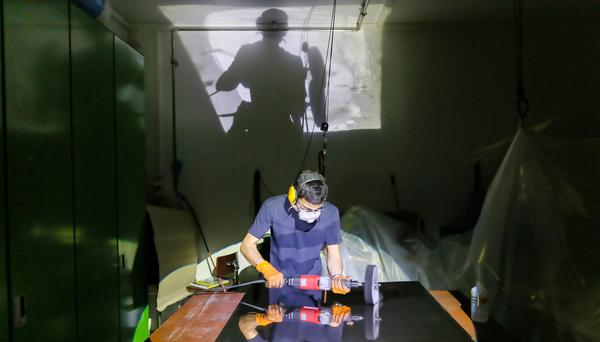Science Shapes Light to Create a Work of Art

© 2015 EPFL
Four aluminum plates tilted skyward transform the vault of the Rolex Learning Center into a giant screen. EPFL researchers used the so-called “caustic” effect of reflection to create bright shapes that morph and move with time and season.
When walking into the Rolex Learning Center, one immediately encounters these 4 large metal plates that are completely smooth and barely curved. On cloudy days it is impossible to imagine what purpose they serve. “The many fingerprints on them testify to the curiosity they generate,” says Mark Pauly, project head. However with a single ray of sunlight, the hidden function of these plates is illuminated. Looking up, one discovers four portraits of great leaders in science and architecture.
Thanks to the caustic effect, Marie Curie, Alan Turing, Eileen Gray and Rachel Carson appear under the vault of the RLC as soon as the light hits the metal plates. This effect can be observed everywhere around us. Glass, water and shiny metal objects often create seemingly random patterns on nearby surfaces through the reflection and refraction of light. When these models are used in computer graphics, they are referred to as caustics. Using algorithms developed by the Computer Graphics and Geometry Laboratory (LGG), researchers were able to control and organize this caustic effect into coherent pictures.
After experimenting with this new technology by initially passing light through transparent acrylic plates, it took Mark Pauly’s team over a year and a half of work to achieve this amazing installation on aluminum plates. This time, however, light is reflected by the material.
“It is a very detailed operation. We had to develop a manufacturing process that ensures the 3D surface computed by our algorithm can be achieved with the necessary precision,” says Romain Testuz, who specializes in digital manufacturing. This new computer algorithm calculates the smallest curvature of the surface to produce the image depending on various parameters such as the direction of light, properties of the material and focal length. What it comes down to is focusing light on the illuminated areas of the image and diverting it from the regions that should be dark.
The artistic and technological installation was completed with the collaboration of EPFL’s ALICE laboratory and ATPR workshop, and was christened, sol.id, in reference to both the sun and to the identity of the personalities in the images selected – and given that these blocks form geometric solids. “By their movement in space, we found that clouds gave an extra dimension to the installation by making the images disappear and reappear like magic,” said computer graphics specialist Yuliy Schwartzburg.
Through the successful installation of sol.id, the researchers were able to show that the algorithms they developed can be used in various fields such as architecture, design or technology. Mark Pauly clarifies: “We are exploring these different avenues via our startup, Rayform.”



